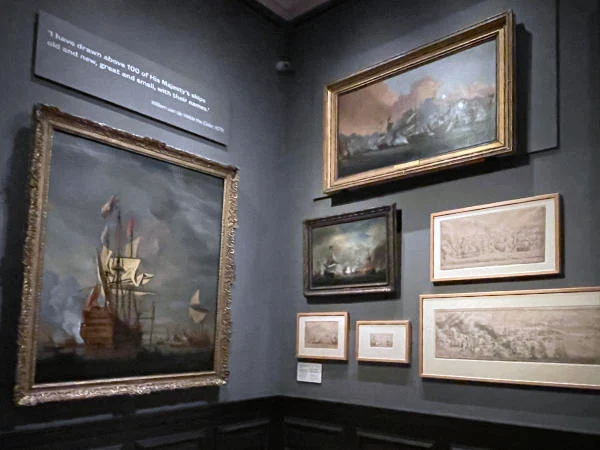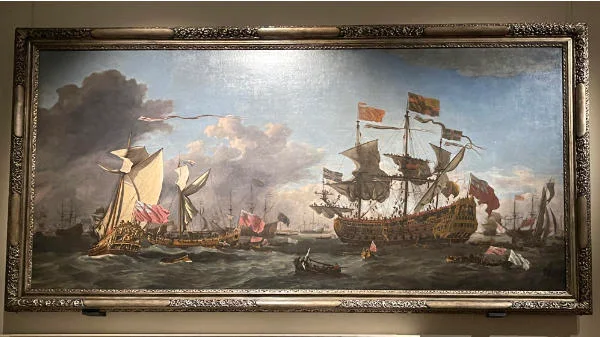I've visited the exhibition of The Van de Veldes: Greenwich, Art and the Sea twice now. However while referencing it extensively in relation to the Landscape Artist of the Year Commission, I've added the review to my long list of "things to do/blog about" without striking it off the very long list.
So this is my review.
What's the exhibition about?
The exhibition celebrates two two Dutch Golden Age artists Willem van de Velde the Elder and his son, Willem van de Velde the Younger - some 350 years after they came to Greenwich following an economic meltdown in Holland.
 |
| a corner of the exhibition showing both drawings and paintings by both father and son |
It highlights:
- their maritime drawings (by father) and paintings ( by son_ and
- their connections to both
- the Netherlands, England and its King in general and
- Greenwich and the Queens House in particular
- how they influenced other painters - including WM Turner.
In addition, the Queen’s House at Greenwich became the home of the studio granted to the two artists by Charles II.
Details of the Exhibition
The exhibition is:
- AT: The Queen’s House, Greenwich - which was designed by Inigo Jones and you may recognise from more than a few historical dramas on film and television!
- BETWEEN: 2 March 2023 – 14 January 2024
- Admission: FREE
- Website: www.rmg.co.uk/van-de-velde
 |
| The Queen's House, Greenwich - March 2023 |
 |
| London from Greenwich Hill (1672) attributed to Johannes Vorsterman - a dutch painter who also worked for Charles II The painting is currently in an exhibition at the Guildhall Gallery, City of London It shows the Queens House on the extreme left at the time the Van der Veldes arrived in London (and which I saw the morning before my second visit!) Note the ships on the River Thames |
Who were the Van de Veldes?
- a salary equivalent to that of his ‘Principal Painter’, Sir Peter Lely; and
- a studio at the Queen’s House - where they worked for the next 20 years.
Willem van de Velde the Elder (1610 - 1693)
 |
Van de Velde the Elder sat drawing the Battle of Scheveningen - the last battle of the first Anglo-Dutch War - from a ship at sea - pen and ink (extract from the drawing below) |
 |
| The Battle of Scheveningen, 10 August 1653 a pen painting or grissaille by Willem van de Velde the Elder (the boat he's sat in is shown bottom left of centre) |
 Subsequently, after his move to London, he is described in his portrait as a "Ships Draughtsman to King Charles II".
Subsequently, after his move to London, he is described in his portrait as a "Ships Draughtsman to King Charles II".Willem van de Velde the Younger (1603 - 1707)
The son was the painter of the two - and I got the impression that he didn't draw a lot. There again who would want to compete with a draughtsman like his father?
I found his portrait - showing him handling drawings of sea battles - to be very curious. To my mind it was clear, that he used his Dad's drawings to construct his own paintings of sea battles and expeditions.
 |
| Painting of Willem van de Velde the Younger |
What I thought about the exhibition
Van de Velde the Elder's drawings in the midst of battle are just jaw-dropping. I've never ever seen anything like it.So was he the first ever "on the spot" war artist who drew what he saw? I rather think he might be.
 |
| an extract of another pen and ink drawing of a battle by Willem van de Velde the Elder which illustrates some of the awful things that happen to ships and people in battles |
 |
| The Burning of the Royal James at the Battle of Solebay, 28 May 1672 |
returning to display in this exhibition will be The Burning of the Royal James at the Battle of Solebay, 28 May 1672, otherwise known as ‘The Solebay Tapestry’. Originally part of a set of six, it is the only Solebay Tapestry in the collection at the Queen’s House, where the original cartoons were first designed by Van de Velde the Elder. In February 2022, Royal Museums Greenwich partnered with the Art Fund to crowdfund £15,000 to save the Solebay Tapestry. The campaign broke records, reaching its target in a single day. This monumental tapestry has been saved from further deterioration and is able to return to display for the first time in over twenty years.
 |
| A Royal Visit to the Fleet in the Thames Estuary, 1672 by Willem Van de Velde the Younger |
One of the most important objects in the exhibition will be the newly conserved painting, A Royal Visit to the Fleet. It was worked on in their studio at the Queen’s House in the 1670s and, at almost four metres across, was the largest seascape Van de Velde the Younger had painted to date. The scale of the painting coupled with a low viewpoint lends it a dramatic, panoramic quality. Following two years of conservation, this commanding painting shows why the legacy of the Van de Veldes helped define English marine painting for the next two hundred years.
The studio
The end room
 |
| "The Ship of Fools" by Kehinde Wiley |
Ship of Fools is a response to the history of Maritime painting, and in a very strong way is about trying to come to terms with the project I have had over the past 10 to 12 years, which is to delve into the history of painting – Gainsborough, Turner, Bosch. To delve into those people whose shoulders I try to stand on. To justifiably create a space for myself.Kehinde Wiley


No comments:
Post a Comment
COMMENTS HAVE BEEN CLOSED AGAIN because of too much spam.
My blog posts are always posted to my Making A Mark Facebook Page and you can comment there if you wish.
Note: only a member of this blog may post a comment.